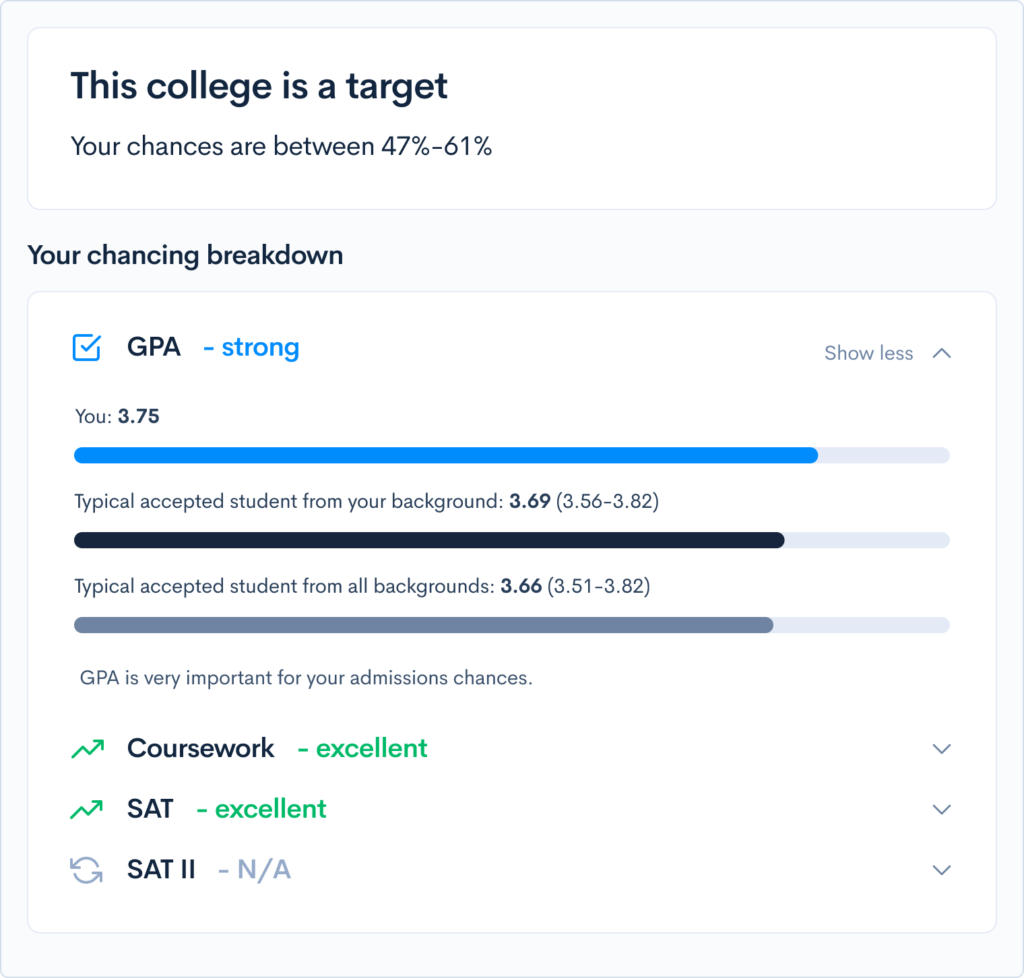UPenn vs. Penn State: 7 Main Differences
Despite their similar names, the University of Pennsylvania (UPenn) and Pennsylvania State University (Penn State) are very different institutions. The former is a member of the Ivy League, founded in 1740 by Benjamin Franklin. The latter was founded in 1855 as the Farmers’ High School of Pennsylvania and went on to become the state’s sole land-grant university eight years later. Both of these schools offer excellent programs for students, but you’ll have a very different experience depending on which you attend. This blog will help you discover numerous differences when comparing UPenn vs. Penn State. Then you’ll have an idea of which school is a better fit for you. Learn more about UPenn and Penn State and see your chances of acceptance. UPenn Penn State Location Philadelphia, PA University Park, PA (main campus) Campus Type Urban Suburban Undergraduate Enrollment 10,019 40,639 Acceptance Rate 8% 56% U.S. News Ranking 8 63 Middle 50% SAT 1470-1550 1240-1410 Middle 50% ACT 34-36 27-33 Sticker Price $79,635 $32,608-35,830 (PA resident) $50,142-53,364 (non-PA resident) Need-blind, no-loan, or meets 100% demonstrated need? Need-blind (US/Canada/Mexico), no-loan, meets 100% of demonstrated need Need-blind While both universities are located in Pennsylvania, the schools are fairly far apart. There’s a several hour commute between UPenn and Penn State’s main campus in University Park (the school has more than 20 campuses in total). UPenn: Philadelphia probably needs no introduction. The early capital of the United States is a mecca of history, culture, arts, and much more. People flock to this destination to climb the famous “Rocky” steps, see the Liberty Bell, dine at renowned restaurants, and visit the many museums. Philadelphia is also a short train or car ride to New York, making it a great weekend or even day trip. Penn State: Meanwhile, Penn State’s main campus is located in a quintessential college town called State College, where the school plays a central role in the economy and culture. From the university’s Beaver Stadium to the Palmer Museum of Art to the many hiking trails, the city has plenty to do but offers a more intimate feel than the bustling city life of Philadelphia. UPenn: UPenn is much smaller than Penn State, with around 10,000 undergraduate students and almost 12,000 graduate students. Penn State: Penn State has more than 76,000 undergraduates across its campuses, with 40,639 at its main campus. There are about 15,000 graduate students at Penn State. Penn State has a larger student-to-faculty ratio — 15:1 to UPenn’s 6:1. UPenn: There are four schools that offer bachelor’s degrees, including: While all of its programs are highly acclaimed, The Wharton School, in particular, is world-renowned, consistently ranked as the top business school. The School of Nursing is also unique in that it’s one of just a few nursing programs for undergraduates. UPenn offers several dual-degree options, such as the Seven Year Bio-Dental Program leading to a B.S. and DMD, The Huntsman Program in International Studies and Business, leading to a B.A. from Arts and Sciences and B.S. from Wharton, and The Roy and Diana Vagelos Program in Life Sciences and Management, leading to a B.A. from Arts and Science and a B.S. from Wharton. The schools within Penn have different requirements. For example, students in Arts and Sciences must complete a General Education Curriculum, aimed at the development of broad skills, participation in a variety of disciplines, and development of different perspectives. Penn State: There are a number of schools and colleges that accept undergraduates: With some exceptions, students can matriculate at any of the campuses and transfer to University Park (State College) as part of the 2+2 Plan. The university also offers two-year associate degrees. There are 6 additional colleges, located throughout the state, that offer majors that are typically completed at campuses other than University Park. These colleges are: Penn State has more than 272 majors. Students who are undecided have many resources to help them clarify their interests and goals, such as advisors and The Division of Undergraduate Studies (DUS), a living-learning program for first-year students. The university has a General Education Program for the undergraduate student body that consists of courses in a number of disciplines, such as writing, natural sciences, and more. Both UPenn and Penn State have robust study abroad programs, with numerous options around the world that vary in duration and type. Penn State sent nearly half of its students abroad in the 2018–19 academic year, while UPenn says it sends roughly 2,500 students to more than 50 countries each year.
UPenn: Undergraduates are required to live in on-campus housing for their first four semesters. The university is home to 12 undergraduate College Houses, and a little over half of the student body lives on campus. First-Year Houses specifically serve freshmen, while Four-Year Houses allow students to mingle with peers from all years. Meanwhile, upperclassmen have the option of apartment-style living. Undergraduates can join Program Communities, which consist of tight-knit communities including students and faculty who have common interests, from film to science and technology to politics. Upperclassmen can propose ideas for Student Designed Communities (SDCs), which are developed into actual facilities. Penn State: Each campus has its own options for housing. At University Park, first-year students are required to live on campus, with 36% of the undergraduate student body living on campus. The university offers Special Living Options (SLOs), residence halls or apartments that build communities around shared interests, such as leadership development, global issues, service, or academic concentrations. In these residences, students create their own activities and programs. UPenn: The university is more expensive than Penn State, with a sticker price of nearly $80,000 to Penn State’s low-mid $30,000s. But, the Ivy League university is committed to meeting 100% of full financial need and has a no-loan policy. In the 2018–19 academic year, 46% of undergraduates received grant-based aid, with an average package of $54,301. Penn State: This school is need-blind, and 73% of students receive some type of financial aid. Loans may be part of the packages. While UPenn doesn’t offer merit scholarships as per the Ivy League agreement, Penn State has a number of merit-based awards, including the Discover Penn State Award, the Provost’s Award, and many others. Approximately 6,700 first-year students receive a University Scholarship. UPenn: The Quakers consist of 25 teams that play in the NCAA Division I and compete in the Ivy League. They are particularly successful in basketball and lacrosse. The university also has more than 450 student-run organizations across multiple disciplines, from performing arts to journalism to politics. Greek life is also a large part of university life — more than a quarter of students participate in nearly 50 fraternities and sororities. Penn State: The Nittany Lions are famous for their renowned football team, which is part of the Big Ten Conference and has won a number of national titles and championships. The program has also been the subject of controversy and scandal. In addition, the university has numerous student groups and organizations, including THON, the largest student-run philanthropy aimed at fighting against pediatric cancer. The yearlong efforts culminate in a 46-hour dance marathon. Greek life has a presence at Penn States as well, with 17% of the student body belonging to a fraternity or sorority. Demographic Breakdown UPenn Penn State International 13.3% 9.36% African American/Black 7.8% 6.40% Native American or Alaskan Native 0.1% 0.13% Asian American/Pacific Islander 22.3% 6.40% Hispanic/Latinx 10.2% 7.65% White 38.7% 64.95% Two or more races 5.1% 3.44% Race/ethnicity unknown 2.5% 2.28% As you can see, UPenn is significantly more diverse than Penn State, but we can likely attribute this to the schools’ status as public or private universities. Penn State, as a public university, admits more in-state students, so the demographic of the school is more likely to resemble that of the state. Both universities have a 5/5 rating on the Campus Pride Index and offer numerous resources, organizations, and more for LGBTQ students and faculty. Now that you have a clearer understanding about the differences between Upenn and Penn State, you may be interested in attending one or the other! A strong academic and extracurricular profile are a great start. Find out your chances of admission to more than 600 schools in the U.S. with CollegeVine’s free chancing engine. This tool not only estimates your odds of acceptance, but it also offers tips on how to boost your chances of admission. What’s Covered:
UPenn vs. Penn State: A Quick Overview
UPenn vs. Penn State: A Closer Look
Location
Size
Academics

Housing
Financial aid
Sports and Extracurriculars
Culture and Diversity
What Are Your Chances of Acceptance?


